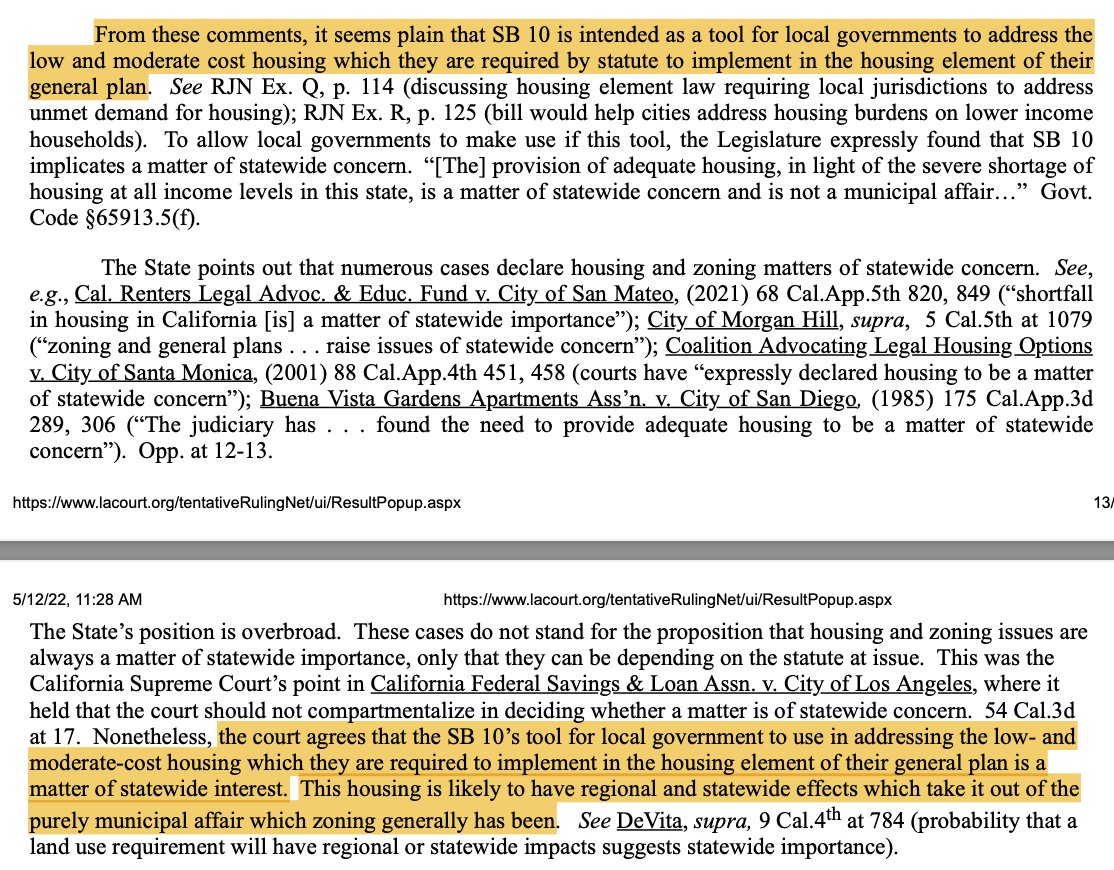
I'm glad for this victory, but the superior court's opinion in this "home rule" case contains some very bad seeds.
It illustrates the importance of building a good record in the trial court, which apparently didn't happen here. 1/13
It illustrates the importance of building a good record in the trial court, which apparently didn't happen here. 1/13
https://twitter.com/AGRobBonta/status/1524866990082433024
At issue: @Scott_Wiener's #SB10, a bill that allows city councils to upzone (w/o CEQA review!) for middle-density housing, notwithstanding local voter-adopted measures that may prohibit it. /2
Plaintiffs brought a facial challenge. Court rejected it, finding SB10 sufficiently well tailored to state interest in affordable housing.
But along the way, court faulted what it called the bill author's "dubious assertions" about CA housing crisis. /3
But along the way, court faulted what it called the bill author's "dubious assertions" about CA housing crisis. /3

"It is hard to see how there is an overall general need for housing where California has suffered a net loss of population over the past several years"
"It is also naïve for SB 10’s author to rely on the state’s 160,000 homeless persons to demonstrate a need for housing" /4
"It is also naïve for SB 10’s author to rely on the state’s 160,000 homeless persons to demonstrate a need for housing" /4
The court ultimately upheld SB 10 on the theory that it helps cities to plan for low- and moderate-income housing specifically, as they're required to do under state's "RHNA" framework /5 

*This* kind of housing, the court says, "is likely to have regional and statewide effects which take it out of the
purely municipal affair which zoning generally has been." /6
purely municipal affair which zoning generally has been." /6
The clear implication is that SB10 and other state housing bills may be constitutionally vulnerable as applied to "luxury" housing. /7
With respect, however, the "dubious assertions" are the court's, not Sen. Wiener's. /8
A) The court seems blithely unaware of the chain-of-moves studies, which show how new "luxury" housing rapidly frees up affordable homes elsewhere in region. /9
https://twitter.com/CSElmendorf/status/1482178143448297472
B) The court seems equally unaware of cross-sectional studies showing that rate at which new housing "filters toward affordability" is slower in regions w/ strict development controls. /10
aeaweb.org/articles?id=10…
aeaweb.org/articles?id=10…
C) Court does not address correlation across states between rates of homelessness and median rents. Yes, the homeless have many problems, but "no place we can afford to rent" is certainly among them. /11
niskanencenter.org/the-obvious-co…
niskanencenter.org/the-obvious-co…
D) Court ignores fact that *high housing prices*, a manifestation of scarcity, are a big reason why CA "has suffered a net loss of population over the past several years." /12
The opinion is remarkably careful in other respects, which leaves my wondering: Do these omissions reflect intentional mine-laying by the judge, or bad record-building by @AGRobBonta's lawyers? /end
• • •
Missing some Tweet in this thread? You can try to
force a refresh










